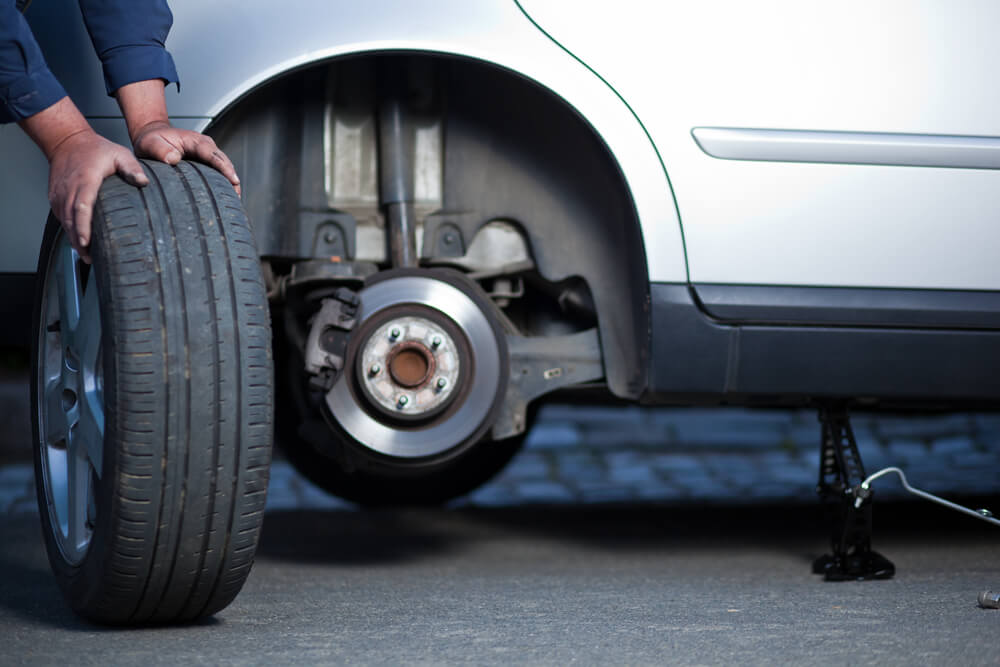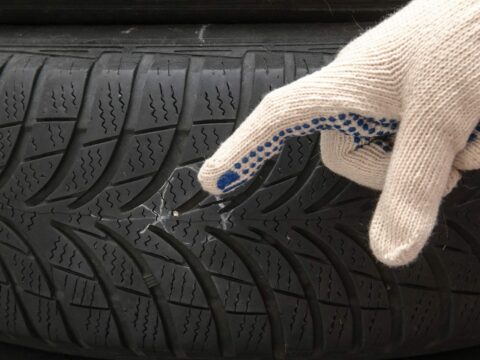Winter tires are a necessity for drivers in cold climates. They require more rubber, meaning they are more expensive than regular ones. Generally, winter tires give you the best traction and control all year, but changing twice a year is heavy for your pocket.
So how do you go about saving costs by changing winter tires? This article discusses how much it costs to change these winter tires and other associated costs. We’ll also look at how much tire service providers charge and how much people pay for changing, mounting, balancing, and storing tires.
Types of Tires Used in the Winter Season
There are a few different types of tires used during winter, each with pros and cons. Let’s have a look at the most common types:
- All-Season Tires: These are designed to be used year-round in both wet and dry conditions. They usually have a higher price tag than other tires. Still, they’re worth it because they last longer and provide better traction in all weather conditions.
- Snow Tires: These are specifically designed for winter driving. They have treads specifically formulated to handle snow and ice, which provides better grip and stability on slippery roads. They also tend to be more expensive than other types of winter tires, but they’re worth it if you plan to use your car in snowy conditions regularly.
- Winter Tires: These are designed for use only in cold weather. They have a more complex rubber compound that provides better traction in icy and snowy conditions. Still, they also tend to be more expensive than other tires.

Winter Tire Costs: What are the Details?
The answer to this question will depend on several factors, including the size of the vehicle, the tire type, and the vehicle’s make and model.
A basic tire swap costs about $10, while tires without rims cost twice or thrice. The price hike is due to its material costs. Winter tires are made with different rubber compounds that provide better traction in cold conditions.
To check whether winter tires are needed, drivers should ask the vehicle manufacturer, as there is no standardized system for determining whether winter tires are required.
Factors to Consider When Choosing Winter Tires
When it comes time to change your winter tires, you may wonder if it is worth the cost. There is no definitive answer as to whether or not it is cost-effective to change your tires. However, a few factors can help you in decision making.
If you’re using low-pressure tires, you’ll likely not be worth the expense. Low-pressure tires work best in warm weather and don’t handle well in cold temperatures. High-pressure tires are designed for colder weather and perform better when driving on snow and ice.
Another factor influencing whether changing your winter tires is cost-effective is how many miles they have been driven. Tires that have been extensively used will likely need to be replaced more frequently than new tires due to increased wear and tear. Replacing them yearly may be cheaper in the long run than using worn-out tires. That’s why you need to know how often you need to get new tires.
Ultimately, it’s essential to consult a qualified tire change mechanic in Toronto, before changing your winter tires. They can provide you with an accurate replacement cost estimate and determine if it’s worth it.
Costs to Be Aware Of When Changing Winter Tires
There are a few cost considerations to look out for when changing winter tires. They are the following:
- Cost of changing tires mounted on rims
- Cost of mounting and balancing tires without rims
- Cost of tire storage
Cost of Changing Tires Mounted on Rims
Changing winter tires mounted on rims typically costs between $60 and $80 per set of 4. This includes the cost of the replacement tire, rim replacement, lug nuts, and wheel alignment. This price doesn’t involve balancing.
The cost of balancing a car’s tires is $32 to $48 per set of four or $8 to $12 per wheel. You should balance the tires every 1 to 2 years when you notice signals such as vibration at high speeds, increase in fuel consumption, or uneven treadwear.
Cost of Mounting and Balancing Tires Without Rims
Unbalancing a tire is risky, so you must balance the tire before driving. Tire mounting and balancing without rims can cost between $60 and $80. This includes the price of the new tire, installation labor, a wheel balancer, and any additional parts needed for installation.
Factors that can affect the cost of these services include:
- Schedule: By appointment, you can get your tire changed at a faster pace and pay more than if you go to an independent shop. However, if you wait until the queue forms, the price may be lower at an independent shop.
- Waiting time: Longer waiting times are cheaper than shorter waiting times.
- The number of tires to be changed: More than one tire may require special tools or extra time to change, increasing the overall cost.
- Location: Independent shops are more likely to be located in business districts, which can add costs to your bill.
- Time of departure: Getting your car fixed before the first snowfall is advisable, as it will be quieter and cheaper.
- Choosing between dealerships or independent shops: Independent tire shops typically charge less than dealerships and large chains, except for Costco.
- Who handles your tires: Experienced mechanics tend to charge more than employees with little experience or interns. This is because they have more knowledge and experience in the mechanical field. However, you can find Tire Butler has affordable pricing packages for tire handling.
- Size of car tires: Tires for smaller passenger cars are sometimes cheaper than tires for larger trucks and SUVs. This is because the smaller tires have less tread, so they wear faster.
Cost of Tire Storage
You should store winter tires in a cool and dry place to prevent them from deteriorating. The initial cost of keeping winter tires is usually around $10 per month.
Some factors that can affect the price of tire storage include:
- Storage types: The cost of storing tires in a climate-controlled environment is more expensive than storing them outside in a shipping container.
- Insurance: Tires insured against damage or theft are more expensive than those not certified.
- Shop choice: Independent tire shops and storage unit companies typically charge less than dealerships and large chains.
Tire Butler provides seasonal tire storage service at an affordable rate.
Changing Winter Tires: The Breakdown

Changing Tires With One Set of Rims
If you remount your rims twice per year, with an estimate of $100 per change, the costs compute as follows:
$100 per change x 2 changes per year x 5 years = $100
It costs around $80 to $100 to swap tires twice a year for a 5-year tire lifespan. The swap costs $200 yearly, adding up to a stunning $100 over five years.
Changing Tires With Two Sets of Rims
Considering each has its own set:
$240 for four steel rims ($50 to $80 per rim)
+ $80 to have winter tires mounted onto the new rims and balanced
+ $80 to have summer tires mounted onto existing rims and balanced
+ $50 per change x 2 swaps per year x next 4 years = $40
= $800
The average cost to have the wheel (tire and rim) switched is less than half what it would cost to keep it unchanged. Still, if you factor in a couple of tire balances over five years, your maintenance costs equal $100 less.
If you own two sets of rims, changing a tire is significantly faster than having only one location. You can change them yourself to reduce costs. The fewer times the tire is taken off and put back on the rim, the less chance of damaging it.
Changing Winter Tires By Yourself Saves Money
Changing your winter tires yourself, rather than paying a professional, can save you money. In some cases, you may be able to do the job for less than $100.
However, there are a few things to keep in mind before you go ahead and change your tires yourself:
- Make sure you have the right tools and supplies to complete the job. This includes a jack and lug wrench, tire pressure gauge, and a bucket or container to catch any fluids that may escape from the tire while it’s being changed.
- Be aware of the safety hazards associated with changing tires yourself. If you’re unfamiliar with how to do the job safely, ask someone else to help you. And be sure to wear safety gear, including gloves, eye protection, and a full face shield when working with tires.
- Be patient. Changing winter tires can be a tedious task if done incorrectly. Allow enough time for the procedure so it doesn’t interfere with your schedule or cause inconvenience.
Tools you’ll need:
- Floor jack (~$150)
- Jack stands (~$40)
- Lug wrench (~$30) or torque wrench (~$60)
- Wheel chocks or blocks (~$25)
You’ll only need around ~$250 to start changing tires yourself. Here’s a tutorial to get you started: https://youtu.be/314HE4aMG-g
FAQ
How do I know when it’s time to change my tires?
Check your tire pressure regularly, and consult your vehicle’s owner’s manual. When your tires show signs of wear, such as dry rot or bulging, it’s time to replace them.
What size tires should I get?
It depends on the driving you do and the climate where you live. Generally speaking, the heavier the vehicle, the larger the tires you should use. If you live in cold weather, choose winter tires with a higher rating.
Should I get steel rims for my winter tires?
Adding steel rims to your winter tires may seem costly, but it could be worth it in the long run. The extra weight of the edges will help keep your car from skidding on icy roads and last longer than regular winter tires.
Plus, if you get caught in a snowstorm and need to make a quick getaway, having steel rims will give you the advantage over other drivers. But make sure you protect your rims and keep your car in good shape.
How do I store winter tires?
One option is to store your winter tires in a garage or attic that is cool and dark. Make sure the tires are completely deflated and stored in a covered container. You should also rotate your winter tires yearly to get them evenly worn.
Do I need winter tires?
The answer depends on your driving habits and where you live. For the most part, most drivers in the northern US and Canada do not need winter tires during the winter months. When temperatures drop below freezing, ice can form on roads and surfaces, making them slick.
Tires with studs help grip these slippery surfaces. Even though you may not need winter tires in the colder months, it is always a good idea to have a set just in case.
If you live in a region that experiences heavy snowfall or icy conditions often, then it is highly recommended to invest in winter tires. They will make driving in these conditions much easier and safer.
Conclusion
If you live in a colder climate, it’s essential to know the cost of changing your winter tires. Keep these tips in mind to help save money on your tire change. Thank you for reading!



